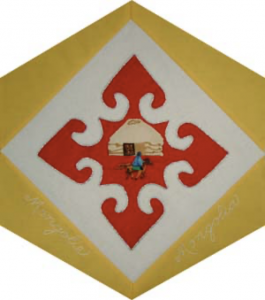Moldova

The Block
Fine elaborate embroidery, an example of which is featured on this block by Julia Sanina and Tatiana Zmeu-Sanina, has been an integral part of Moldovan culture for many years. Such needlework is customarily used to decorate the skirts, blouse sleeves and jackets of national costumes, as well as many types of household linens. Mirrors are often surrounded with embroidered towels and it is a common practice to adorn rooms with embroidered fabrics. Although influenced by Russia, Turkey and Romania, Moldova has developed its own distinctive needlework designs. The geometric pattern of this piece incorporates a number of traditional elements, each with its own meaning. Squares symbolize wealth; diamonds are a sign of family prosperity; horns reflect the desire to have a large herd of cattle, straight paths express wishes for happiness; and the winding paths represent creeks or rivers, full of water. Colours are equally important as each has its own meaning as well. White stands for purity, truthfulness and sincerity; blue denotes peace; green signifies calmness; black represents the soil and fertility; and red, the blood spilled in defence of the country.
Cultural Profile
Moldova is a small landlocked country in south-eastern Europe. In 1940 much of its eastern territory––which at the time was known as Bessarabia––was joined to part of the Moldavian Autonomous Soviet Republic. The united areas formed the Moldavian Soviet Socialist Republic; the second smallest republic of the former USSR. With the collapse of the USSR in 1991, Moldova became an independent nation. Moldova contains an extensive river system (more than 3,000 rivers and streams pass through it) and its terrain is primarily a hilly plain interspersed with deep river valleys. The temperate climate and fertile soil support the cultivation of a variety of crops, including wheat, corn and sunflowers. There are also extensive fruit orchards. It is home to some of the biggest vineyards in Eastern Europe, as well as the biggest wine cellar in the world, some 200 km long. Wine making is a common practice in Moldova, with most people making their own. In addition, beekeeping and silkworm breeding are widespread throughout the nation. Approximately 69 percent of the population is comprised of ethnic Moldavians––who are ethnically kindred to the Romanians–– but there are also Russians, Ukrainians and Gagauz, whose territory was granted its own flag and parliament in the 1990s. The official language of Moldova is Romanian. Moldova has an extremely rich folk culture in which the ancient folk ballad, the Miorita, holds special significance. The narrative drama, which children learn at an early age and carry with them all their lives, tells the story of a little lamb and her young shepherd. Traditional celebrations include the Christian holidays such as Christmas and especially Easter, when eggs are dyed red and embellished with intricate motifs. Each village also celebrates hram, or ‘church day’, when family and friends gather to celebrate the anniversary of the establishment of a village’s church Traditional music and dance––which is promoted at the national level––is represented by groups such as Doina and Joc. Traditional musical instruments include the naiul, a curved Pan flute. Time-honoured handcrafts, including ceramics and weaving, continue in many areas of the country. Carpet making is another integral part of Moldovan culture and currently exists in several different forms: domestic, industrial and professional. There are many examples of older carpets made in Moldova: as prized possessions, they usually stay within families for generations and are rarely sold. Embroidery, the making of embossed pottery, mural painting and wood-carving are valued practises that continue. Emigration has played a large role in the demographic evolution of Moldova. It is estimated that 25% of Moldovan people actually live abroad. People have been coming to Canada from Moldova for many years and the 2011 census indicates almost 8,050 Moldavians now live here.
Sponsor: : Marion Brazier in memoriam, from her friends, in Occupational Therapy/Recreation at Trillium Health Centre (formerly Mississauga Hospital).
